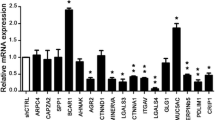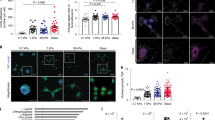Abstract
Background: We have shown in FG pancreatic cancer cells that α2β1 integrin-mediated type I collagen adhesion decreases parathyroid hormone-related protein (PTHrP), inerleukin-6 (IL-6), and interleukin-8 (IL-8) expression, decreases the localization of E-cadherin and β-catenin in cell-cell contacts, increases cell migration, and increases glycogen synthase kinase 3 (GSK3) and protein kinase B (PKB/Akt) phosphorylation states relative to α5β1 integrin-mediated fibronectin (Fn) adhesion.
Aim of the Study: To extend our observations in FG cells to other pancreatic cancer cell lines, and to determine whether E-cadherin-mediated cell-cell adhesion and its downstream effectors were functionally involved in the ECM-mediated regulation of PTHrP, IL-6, and IL-8.
Methods: We used standard biochemical techniques to determine ECM-specific differences in E-cadherin and β-catenin localization, GSK3 and PKB/Akt phosphorylation, haptokinetic cell migration, and cytokine expression in pancreatic cancer cells. We also conducted functional studies using pharmacological inhibitors for GSK3 and PKB/Akt, as well as elevated Mg2+/Ca2+ ratios similar to pancreatic juice, and examined their effects on cytokine expression.
Results: Differences in E-cadherin and β-catenin localization along with GSK3 and PKB/Akt phosphorylation occur in multiple pancreatic cancer cell lines, resulting in differences in ECM-mediated haptokinesis and cytokine expression that are generally consistent with previous observations in FG cells. Our functional studies also suggest that E-cadherin-mediated cell-cell adhesion and downstream effectors are involved in PTHrP, IL-6, and IL-8 expression.
Conclusions: These data indicate that α2β1 integrin-mediated type I collagen adhesion disrupts cell-cell adhesion architecture, resulting in increased migration and decreased PTHrP, IL-6, and IL-8 expression in pancreatic cancer cells.
Similar content being viewed by others
References
Bardeesy N, DePinho RA. Pancreatic cancer biology and genetics. Nat Rev Cancer 2002;2(12):897–909.
Lohr M, Trautmann B, Gottler M, et al. Human ductal adenocarcinomas of the pancreas express extracellular matrix proteins. Br J Cancer 1994;69(1):144–151.
Linder S, Castanos-Velez E, von Rosen A, Biberfeld P. Immunohistochemical expression of extracellular matrix proteins and adhesion molecules in pancreatic carcinoma. Hepatogastroenterology 2001;48(41):1321–1327.
Tani T, Lumme A, Linnala A, et al. Pancreatic carcinomas deposit laminin-5, preferably adhere to laminin-5, and migrate on the newly deposited basement membrane. Am J Pathol 1997;151(5):1289–1302.
Tempia-Caliera AA, Horvath LZ, Zimmermann A, et al. Adhesion molecules in human pancreatic cancer. J Surg Oncol 2002;79(2):93–100.
Iacobuzio-Donahue CA, Ashfaq R, Maitra A, et al. Highly expressed genes in pancreatic ductal adenocarcinomas: a comprehensive characterization and comparison of the transcription profiles obtained from three major technologies. Cancer Res 2003;63(24):8614–8622.
Iacobuzio-Donahue CA, Maitra A, Olsen M, et al. Exploration of global gene expression patterns in pancreatic adenocarcinoma using cDNA microarrays. Am J Pathol 2003;162(4):1151–1162.
Armstrong T, Packham G, Murphy LB, et al. Type I collagen promotes the malignant phenotype of pancreatic ductal adenocarcinoma. Clin Cancer Res 2004;10(21):7427–7437.
Bachem MG, Schunemann M, Ramadani M, et al. Pancreatic carcinoma cells induce fibrosis by stimulating proliferation and matrix synthesis of stellate cells. Gastroenterology 2005;128(4):907–921.
Grzesiak JJ, Clopton P, Chalberg C, et al. The extracellular matrix differentially regulates the expression of PTHrP and the PTH/PTHrP receptor in FG pancreatic cancer cells. Pancreas 2004;29(2):85–92.
Grzesiak JJ, Smith KC, Burton DW, Deftos LJ, Bouvet M. GSK3 and PKB/Akt are associated with integrin-mediated regulation of PTHrP, IL-6 and IL-8 expression in FG pancreatic cancer cells. Int J Cancer 2005;114:522–530.
Ruoslahti E. RGD and other recognition sequences forintegrins. Annu Rev Cell Dev Biol 1996;12:697–715.
Wong NA, Pignatelli M. Beta-catenin—a linchpin in colorectal carcinogenesis? Am J Pathol 2002;160(2):389–401.
Abdeen O, Pandol SJ, Burton DW, Deftos LJ. Parathyroid hormone-related protein expression in human gastric adenocarcinomas not associated with hypercalcemia. Am J Gastroenterol 1995;90(10):1864–1867.
Carron JA, Fraser WD, Gallagher JA. PTHrP and the PTH/PTHrPreceptor are co-expressed in human breast and colon tumours. Br J Cancer 1997;76(8):1095–1098.
Yeung SC, Eton O, Burton DW, Deftos LJ, Vassilopoulou-Sellin R, Gagel RF. Hypercalcemia due to parathyroid hormone-related protein secretion by melanoma. Horm Res 1998;49(6):288–291.
Deftos LJ. Granin-A, parathyroid hormone-related protein, and calcitonin gene products in neuroendocrine prostate cancer. Prostate Suppl 1998;8:23–31.
Bouvet M, Nardin SR, Burton DW, et al. Human pancreatic adenocarcinomas express parathyroid hormone-related protein. J Clin Endocrinol Metab 2001;86(1):310–316.
Bouvet M, Nardin SR, Burton DW, et al. Parathyroid hormone-related protein as a novel tumor marker in pancreatic adenocarcinoma. Pancreas 2002;24(3):284–290.
Hastings RH, Burton DW, Quintana RA, Biederman E, Gujral A, Deftos LJ. Parathyroid hormone-related protein regulates the growth of orthotopic human lung tumors in athymic mice. Cancer 2001;92(6):1402–1410.
Bakre MM, Zhu Y, Yin H, et al. Parathyroid hormone-related peptide is a naturally occurring, protein kinase A-dependent angiogenesis inhibitor. Nat Med 2002;8(9):995–1003.
Gradl D, Kuhl M, Wedlich D. The Wnt/Wg signal transducer beta-catenin controls fibronectin expression. Mol Cell Biol 1999;19(8):5576–5587.
Levy L, Neuveut C, Renard CA, et al. Transcriptional activation of interleukin-8 by beta-catenin-Tcf4. J Biol Chem 2002;277(44):42,386–42,393.
Huber O, Korn R, McLaughlin J, Ohsugi M, Herrmann BG, Kemler R. Nuclear localization of beta-catenin by interaction with transcription factor LEF-1. Mech Dev 1996;59(1):3–10.
Jan Y, Matter M, Pai JT, et al. A mitochondrial protein, Bit1, mediates apoptosis regulated by integrins and Groucho/TLE corepressors. Cell 2004;116(5):751–762.
Pasqualini R, Bourdoulous S, Koivunen E, Woods VL, Jr., Ruoslahti E. A polymeric form of fibronectin has antimetastatic effects against multiple tumor types. Nat Med 1996;2(11):1197–1203.
Brinkmeier ML, Potok MA, Cha KB, et al. TCF and Groucho-related genes influence pituitary growth and development. Mol Endocrinol 2003;17(11):2152–2161.
Castanos-Velez E, Biberfeld P, Patarroyo M. Extracellular matrix proteins and integrin receptors in reactive and non-reactive lymph nodes. Immunology 1995;86(2):270–278.
Lee BH, Ruoslahti E. alpha(5)beta(1) integrin stimulates Bcl-2 expression and cell survival through Akt, focal adhesion kinase, and Ca(2+)/calmodulin-dependent protein kinase IV. J Cell Biochem 2005;95(6):1214–1223.
Shi Q, Abbruzzese JL, Huang S, Fidler IJ, Xiong Q, Xie K. Constitutive and inducible interleukin 8 expression by hypoxia and acidosis renders human pancreatic cancer cells more tumorigenic and metastatic. Clin Cancer Res 1999;5(11):3711–3721.
Friess H, Guo XZ, Nan BC, Kleeff O, Buchler MW. Growth factors and cytokines in pancreatic carcinogenesis. Ann N Y Acad Sci 1999;880:110–121.
Naka T, Nishimoto N, Kishimoto T. The paradigm of IL-6: from basic science to medicine. Arthritis Res 2002;4(Suppl 3):S233-S242.
Becker C, Fantini MC, Schramm C, et al. TGF-beta suppresses tumor progression in colon cancer by inhibition of IL-6 trans-signaling. Immunity 2004;21(4):491–501.
Wang AC, Fu L. Fibronectin regulates the activation of THP-1 cells by TGF-beta1. Inflamm Res 2001;50(3):142–148.
Grzesiak JJ, Davis GE, Kirchhofer D, Pierschbacher MD. Regulation of alpha 2 beta 1-mediated fibroblast migration on type I collagen by shifts in the concentrations of extracellular Mg2+ and Ca2+. J Cell Biol 1992;117(5):1109–1117.
Grzesiak JJ, Pierschbacher MD. Changes in the concentrations of extracellular Mg++ and Ca++ down-regulate E-cadherin and up-regulate alpha 2 beta 1 integrin function, activating keratinocyte migration on type I collagen. J Invest Dermatol 1995;104(5):768–774.
Grzesiak JJ, Pierschbacher MD. Shifts in the concentrations of magnesium and calcium in early porcine and rat wound fluids activate the cell migratory response. J Clin Invest 1995;95(1):227–233.
Ishihara N, Yoshida A, Koizumi M. Metal concentrations in human pancreatic juice. Arch Environ Health 1987;42(6):356–360.
Thomas GM, Frame S, Goedert M, Nathke I, Polakis P, Cohen P. AGSK3-binding peptide from FRAT1 selectively inhibits the GSK3-catalysed phosphorylation of axin and beta-catenin. FEBS Lett 1999;458(2):247–251.
Bax B, Carter PS, Lewis C, et al. The structure of phosphorylated GSK-3beta complexed with a peptide, FRAT-tide, that inhibits beta-catenin phosphorylation. Structure (Camb) 2001;9(12):1143–1152.
Smith U, Carvalho E, Mosialou E, Beguinot F, Formisano P, Rondinone C. PKB inhibition prevents the stimulatory effect of insulin on glucose transport and protein translocation but not the antilipolytic effect in rat adipocytes. Biochem Biophys Res Commun 2000;268(2):315–320.
Deftos LJ, Gazdar AF, Ikeda K, Broadus AE. The parathyroid hormone-related protein associated with malignancy is secreted by neuroendocrine tumors. Mol Endocrinol 1989;3(3):503–508.
Kirchhofer D, Grzesiak J, Pierschbacher MD. Calcium as a potential physiological regulator of integrin-mediated cell adhesion. J Biol Chem 1991;266(7):4471–4477.
Menke A, Philippi C, Vogelmann R, et al. Down-regulation of E-cadherin gene expression by collagen type I and type III in pancreatic cancer cell lines. Cancer Res 2001;61(8):3508–3517.
Weinel RJ, Neumann K, Kisker O, Rosendahl A. Expression and potential role of E-cadherin in pancreatic carcinoma. Int J Pancreatol 1996;19(1):25–30.
Toyoda E, Doi R, Koizumi M, et al. Analysis of E-, N-cadherin, alpha-, beta-, and gamma-catenin expression in human pancreatic carcinoma cell lines. Pancreas 2005;30(2):168–173.
Peng B, Fleming JB, Breslin T, et al. Suppression of tumorigenesis and induction of p15(ink4b) by Smad4/DPC4 in human pancreatic cancer cells. Clin Cancer Res 2002;8(11):3628–3638.
Sipos B, Moser S, Kalthoff H, Torok V, Lohr M, Kloppel G. A comprehensive characterization of pancreatic ductal carcinoma cell lines: towards the establishment of an in vitro research platform. Virchows Arch 2003;442(5):444–452.
Monti P, Marchesi F, Reni M, et al. A comprehensive in vitro characterization of pancreatic ductal carcinoma cell line biological behavior and its correlation with the structural and genetic profile. Virchows Arch 2004;445(3):236–247.
Shimizu H, Julius MA, Giarre M, Zheng Z, Brown AM, Kitajewski J. Transformation by Wnt family proteins correlates with regulation of beta-catenin. Cell Growth Differ 1997;8(12):1349–1358.
Knudsen KA, Soler AP, Johnson KR, Wheelock MJ. Interaction of alpha-actinin with the cadherin/catenin cell-cell adhesion complex via alpha-catenin. J Cell Biol 1995;130(1):67–77.
Miyamoto H, Murakami T, Tsuchida K, Sugino H, Miyake H, Tashiro S. Tumor-stroma interaction of human pancreatic cancer: acquired resistance to anticancer drugs and proliferation regulation is dependent on extracellular matrix proteins. Pancreas 2004;28(1):38–44.
Sawai H, Yamamoto M, Okada Y, et al. Alteration of integrins by interleukin-1alpha in human pancreatic cancer cells. Pancreas 2001;23(4):399–405.
Lohr M, Trautmann B, Gottler M, et al. Expression and function of receptors for extracellular matrix proteins in human ductal adenocarcinomas of the pancreas. Pancreas 1996;12(3):248–259.
Ruoslahti E, Noble NA, Kagami S, Border WA. Integrins. Kidney Int Suppl 1994;44:S17-S22.
Hynes RO. Integrins: bidirectional, allosteric signaling machines. Cell 2002;110(6):673–687.
Brabletz T, Spaderna S, Kolb J, et al. Down-regulation of the homeodomain factor Cdx2 in colorectal cancer by collagen type I: an active role for the tumor environment in malignant tumor progression. Cancer Res 2004;64(19):6973–6977.
Hodivala KJ, Watt FM. Evidence that cadherins play a role in the downregulation of integrin expression that occurs during keratinocyte terminal differentiation. J Cell Biol 1994;124(4):589–600.
Mangin M, Ikeda K, Dreyer BE, Broadus AE. Identification of an up-stream promoter of the human parathyroid hormone-related peptide gene. Mol Endocrinol 1990;4(6):851–858.
Foley J, Dann P, Hong J, et al. Parathyroid hormone-related protein maintains mammary epithelial fate and triggers nipple skin differentiation during embryonic breast development. Development 2001;128(4):513–525.
Troussard AA, Mawji NM, Ong C, Mui A, St-Arnaud R, Dedhar S. Conditional knock-out of integrin-linked kinase demonstrates an essential role in protein kinase B/Akt activation. J Biol Chem 2003;278(25):22,374–22,378.
Shimoyama S, Gansauge F, Gansauge S, Oohara T, Beger HG. Altered expression of extracellular matrix molecules and their receptors in chronic pancreatitis and pancreatic adenocarcinoma in comparison with normal pancreas. Int J Pancreatol 1995;18(3):227–234.
Menke A, Adler G. TGFbeta-induced fibrogenesis of the pancreas. Int J Gastrointest Cancer 2002;31(1–3):41–46.
Lohr M, Schmidt C, Ringel J, et al. Transforming growth factor-betal induces desmoplasia in an experimental model of human pancreatic carcinoma. Cancer Res 2001;61(2):550–555.
Author information
Authors and Affiliations
Corresponding author
Rights and permissions
About this article
Cite this article
Grzesiak, J.J., Smith, K.C., Chalberg, C. et al. Type I collagen and divalent cation shifts disrupt cell-cell adhesion, increase migration, and decrease PTHrP, IL-6, and IL-8 expression in pancreatic cancer cells. Int J Gastrointest Canc 36, 131–146 (2005). https://doi.org/10.1385/IJGC:36:3:131
Issue Date:
DOI: https://doi.org/10.1385/IJGC:36:3:131




